#IBM PC Model 5150
Explore tagged Tumblr posts
Photo


source
#IBM#IBM PC Model 5150#1981#80s#80s tech#techcore#technology#computers#old computers#old tech#computer insides
909 notes
·
View notes
Text

IBM Model 5150 PC that I'm going to try to repair!
@kandiyaki
Let’s play a game
Everyone post the most recent picture in your camera roll. You only get one sentence to justify yourself if you wish. This one is mine.

My boyfriend is rly good at Latin, so I was looking up how to say ‘I love you’ but found this instead :)
Your turn!
@bookmovietvworm
@myfairkatiecat
@i-am-a-fish
@valtsv
7K notes
·
View notes
Text
Word-wise-Czardom (mostly onto now evil & less evil deeds and overall tools from Microsoft & soon enough FAANG) "studies" [WIP]

As much as it pains me to dedicate time to what is now mostly proprietary software corporations, I kinda have to admit such haven't fully came to their current status out of a vacuum. And as I felt like it could be a great gateway for folks out there to get a power-journey into their technological stacks with historical baggage and tinkering / practice exercises / suggestions. Also borrowed a "MS-DOS for dummies" and a computation history "Of Mice and Men" books on my side to scan, study and process from my hometown public library as to get some very rudimentary content to get people hooked from into the journey towards FLOSS content / computation stacks / "deques". Enjoy!
First, we start with the technical considerations derived from the SCP Gazelle... and IBM 5150 personal computer. (the SeattleComputerProducts Gazelle is mostly at the later end of the video but yk, I provide sources with additional informations as I see fit; Providing the hardware specifications of this specific series of that SCP computer soon enough...)
youtube
Essentially boils down to 86DOS / QDOS becoming PC-DOS & MS-DOS 1.25 / 2.0 . And as a result SCP Gazelle & IBM 5150 specifications being the baseline for such early editions of Microsoft operating system efforts alongside Xenix (abandonned later, competing with UnixSystemV) and XEDOS (abandonned sooner, mixture between Xenix and MS-DOS) .
Soon, I am gonna run a Gazelle+Perq+5150-inspired virtual machine and a couple of video demonstrations relatively soon and pipeline my way across that Micro-Soft pipeline from a 8086-powered 16-bit machine on my way from earliest decent release towards a Windows 11-style build. Also gonna tinker alot around the "Windows 8 but on 16-bit MS-DOS 8" pun and a couple of cool "Windows 2.11 for 386 quite packed" + "Windows ME with alternative NT inspired micro-kernel"... things. Definitely gonna dual-boot at least between official Microsoft releases on snapshots & FreeDOS for ease-of-use and overall stronger technical enjoyment.
First draft for my very own virtual-first hardware-faculative "Sascha Heike" computer build from 86-DOS 1.14 ( PC-DOS 1.0 / MS-DOS 1.25 ) to a "OpenSource+Libre+Transparent+Light" Win11 workflow
Initial specifications for the virtual machine model aka "Edition #1" +Intel 8086 CPU +2x 128KB SRAM cards +MonochromeDisplayAdapter(MDA)+OrchidGraphicsAdapter equivalence graphics card +some better sound card than the built-in PC speaker as of the 5150 from the get go +2x 8" floppy drives +1x 8'' Winchester disk +Either Amber or White monochrome CRT monitor +Keyboard (IBM Model F Keyboard?) +MS-DOS 1.25 / 2.0 & PC-DOS 1.0 & FreeDOS (always keep FreeDOS up-to-date regardless) multi-boot operating systems bootloader configuration and overall setup +MicrodotLinux & System III & System V & xv6
First upgrade aka "Edition #2" +Color CRT monitor +Pointing device (either a Touchpad or a Lightpen) +3x 128KB SRAM cards ~Either a Plantronics ColorPlus, a entry-level Hercules Graphics Card or a ColorGraphicsAdapter (CGA) ~From the Intel 8086 to a either AMD 386-tier CPU or Intel 80386 CPU +Intel 8087 Coprocessor ~Update MS-DOS to at least 5.0 but not after that major edition (so no 6.22, no 7.0 nor 8.0 yet) +install "Windows 2.11 for 386" +possibly a decent Xenix version ~2x 5.25" floppy drives +Xerox Rooms for Windows +hDC Windows Express?
Second upgrade aka "Edition #3" ~Touchscreen portrait CRT color monitor... +Windows 3.0 with MME (Multi-Media Extensions) +Windows 3.11 for Workgroups +Microsoft Bob shell & its GreatGreetings extension software +MagicCap for Windows ~Even better sound card (probably Adlib SoundBlaster) ~Video Graphics Array card? ~Update MS-DOS to 6.22 (not 7.0 or 8.0 yet) ~Decent Mouse ~New PS/2 Keyboard ~2x 3.5" floppy drives ~12-48MB of RAM
Third upgrade aka "Edition #4" +Windows 95 +4DOS +Netscape Navigator +16-bit VDM integration +Lynx browser +Latest GNU Hurd build for 32-bit x86 +3DNA 1.0 & 1.1 +OpenVMS? +OS/2 Warp 4? +3DNA 1.0/1.1?
Fourth upgrade aka "Edition #5" +Windows 98 SE +ArcaOS +BeOS +Haiku +Novell network Unixware +IBM Lotus Smartsuite? +Microsoft FrontPage ~CSS1 ~HTML3.5
Fifth upgrade aka "Edition #6" +Windows ME +Interix +16-bit MS-DOS flex tile grid program(s) out of the look in Windows 8 & 8.1 +Linux distro with TDE ~CDE ~XHTML ~CSS2 ~Batch scripting
Sixth upgrade aka "Edition #7" +Windows XP & early Windows Vista +OpenSolaris from SunMicrosystems last open source build +Linux Slackware distribution ~TDE/early KDE (before the Plasma revamp) +Microkernel NT as per Andrew Taunenmaum expectaions +Python interpreter +Powershell +Mozilla Firefox ~HTML4 ~XML+XSL
Seventh upgrade aka "Edition #8" +late Windows Vista and Windows 7 +illumos' OpenIndiana +Debian ~RegEdit ~Sys32 utilities ~Lightweight options -Privacy-violating services & other telemetry disabled / purged from the system ~DirectX9 / 10 / 11 ~OpenGL ~HTML5 ~CSS3 ~Vulnerability exploit of the embedded spyware processor (& microcode) that uses MINIX3 to minimize hardware telemetry
Eight upgrade aka "Edition #9" +Windows 8 & 8.1 +Windows 10 & 10X +Windows 11 onwards +Vulkan +Devuan +Artix? ~ Repurposing of the embedded spyware processor (& microcode) using MINIX3 & reverse-engineering my way towards such a outcome ~KDE Plasma 5.27 & release candidate of preview 6 ~nsCDE ~LinuxSubsystemForWindows ~WindowsSubsystemForLinux +Git & SubVersion ~Sandbox ~Other legacy functionalities & tweaks (like screensavers, fully custom themes, wallpapers, skins, sounds, mouse pointers, widgets, et cetera.)
Let me know if you want to see such learnblr lively studious dives and how to contribute to the documentation process, because while I have a abundance of ideas, I wouldn't mind to share the burden / delegate some to other people as they wish. Only if you so wish though no worries.
Here's a little wrapped gift for you all before I leave you for tonight (very D&D 5E oriented tomorrow due to the game session happening onto that day's evening / night)
+Asahi Linux? (closer to macOS and Darwin family) +xv6 & Plan9 & inferno (closer to Bell Labs' research Unix family) +FreeBSD & OpenBSD & NetBSD (closer to BSD family) +OpenGenera & Mezzano & ChrysaLisp (closer to the larger Lisp family) +ToaruOS +SerpaeOS +SerenityOS +KolibriOS +HelenOS +SyllableDesktop +Redox & PhantomOS +Ghost +ITS +TROPIX +CTSS +COS-310 +Harmony +ShareOS +WozMon +Concurrent MP/M +Apple SOS +UMES +IBSYS +IPL (Information Processing Language for the IBM 701) +GECOS +OS/360 & DOS/360 +TSS/8 with SeattleComputerMuseumPlus tweaks like Lisp 1.5 and 6 available users (Seattle Comptuer Museum PDP-8/E TSS/8 lively runtime timesharing shared exclusively on Mastodon until the project shutdown during the pandemic in ~2020-2021) +Hercules emulator & AIX +IBM i & Linux on IBM Z +BESYS +UNIVAC? +nyxt +QBASIC (Advanced Integer BASIC) +Applesoft BASIC +Swift +UCSD Pascal +TinyBASIC +AppleDOS +Steve Wozniak's Apple Disk II +Apple ProDOS +dBase & WordStar (CP/M software) +AROS (closer to later Commodore, around the Amiga) +ZealOS (TempleOS fork, closer to earlier Commodore, around the Commodore 64 and its KERNAL) +Parade (XXIIVV's Paradise operating system) +Armbian? +Libreboot +IBM Lotus Notes +RISC-V application-tier 64-bit data processor +Selectric / Timex Rotor Machine / RadioTeleType / TV-typewriter device
1 note
·
View note
Text


Vintage PC Collection (ibm 5150, 5160, model 25, and more)
1K notes
·
View notes
Text
xterm-16color
my very first nft release, xterm-16color, is a meta-heavy collection of tokens that i spent about 6 weeks creating. they were released in april '21
i was not aware of the environmental impact ethereum had back then, but shortly after this release i found out about this aspect when i discovered hicetnunc and tezos nfts
i switched over to releasing artworks on tezos instead, but now that ethereum has resolved the environmental impact i'm happy to list the remaining tokens again and explore the possibility of doing another ethereum release in the future
i have included images of all of the tokens below as well as their descriptions below in chronological order

from the collections opensea page:
8950 4e47 0d0a 1a0a 0000 000d 4948 4452 0000 0004 0000 0004 0802 0000 0026 9309 2900 0000 2449 4441 5408 5b25 8881 0d00 000c c19c ee34 9f59 1742 0909 59c6 bf36 ec24 d0e5 59da 0785 0e7a 5714 35be 95e5 4800 0000 0049 454e 44ae 4260 82
A personal computing journey.
40 years of computing history, distilled into 16 pixels; from before graphics existed, through their inception, and finally, to a glimpse of what lies ahead.
We stop at important milestones and take a moment to reflect on what was once the cutting edge.
Each pixel was hand-crafted using technology available from the associated era. They were then embedded into companion pieces, using their raw data, in a way that embodies the artists personal experience at the time.
They have also been encoded into each NFTs metadata, and are accompanied with details of the hardware required to exhibit them as the artist intends, along with 1 of 17 clues to their true identity.
~~~
some info about the tokens in the collection:
0x00.bas
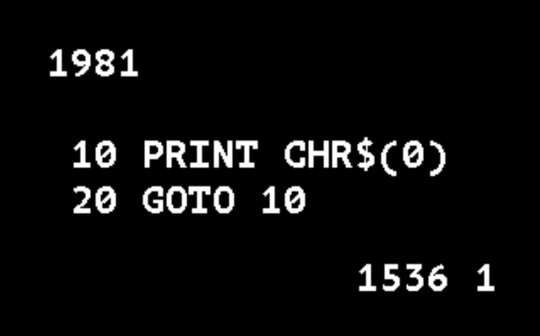
0x31, 0x30, 0x20, 0x50, 0x52, 0x49, 0x4e, 0x54, 0x20, 0x43, 0x48, 0x52, 0x24, 0x28, 0x30, 0x29, 0x0a, 0x32, 0x30, 0x20, 0x47, 0x4f, 0x54, 0x4f, 0x20, 0x31, 0x30, 0x0a
Represents the time before; the void, null, the absence of pixels, and the beautiful simplicity behind the endless loop that is our shared existence.
A BASIC file created for a 5150 IBM PC, running PC-DOS 1.0, on a 320x200 resolution CGA display, with an Intel 8008 @ 4.77 MHz, 64kb of RAM, and a single 160kb 5.25" floppy drive.
Executing the file will print nulls to the screen in a loop.
Reserved for artist, not for sale.
~
0x01.logo

PU FD 1 PD FD 248 RT 90 FD 1 RT 90 REPEAT 159 [ FD 250 LT 90 FD 1 LT 90 FD 250 RT 90 FD 1 RT 90 ] FD 250 HT FULLSCREEN
Generates a single black (0x000000) pixel.
A file containing Logo commands created for a Revision B IBM PC running PC-DOS 2.0 and IBM Logo 1.0, attached to a CGA display set to show 320x250 dots in Logo, on an Intel 8008 @ 4.77 MHz with 640kb of RAM and an 8087 math co-processor, with 2x 160kb 5.25" floppy drives, a 300bps Hayes Smartmodem and a 1 megabit-per-second Orchid Technology PCNet LAN card.
~
0x02.tga
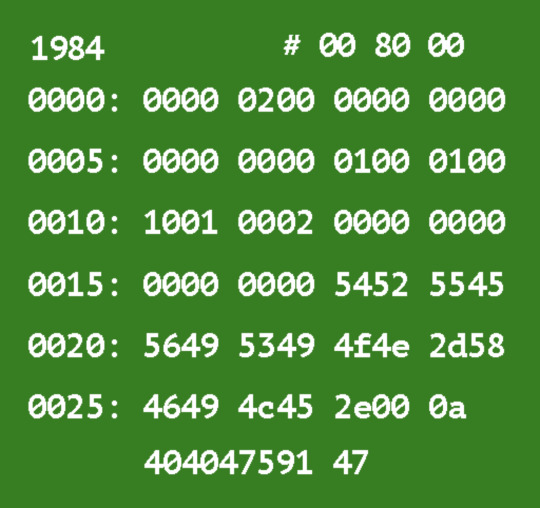
00 00 02 00 00 00 00 00 00 00 00 00 01 00 01 00 10 01 00 02 00 00 00 00 00 00 00 00 54 52 55 45 56 49 53 49 4f 4e 2d 58 46 49 4c 45 2e 00 0a
A single green (0x008000) pixel.
Represents television and its contribution to the progression of computer graphics over time.
A TGA file created for an IBM compatible Compaq Deskpro model 1, running an Intel 8086 processor @ 7.14Mhz, with 1MB of RAM, 2x floppy disk drives, and a 10MB hard drive, a TARGA 16 video card attached to a compatible display at 512x482 resolution, and a 1200bps Hayes Smartmodem 1200 running Truevision Image Processing Software (TIPS) on MS-DOS 2.11
~
0x03.bmp
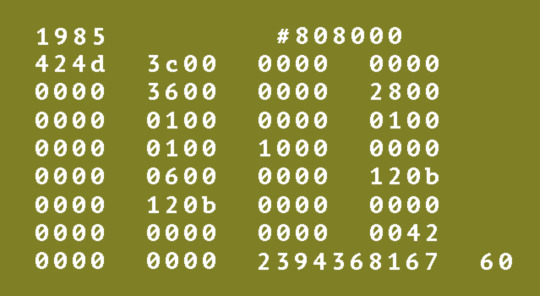
42 4d 3c 00 00 00 00 00 00 00 36 00 00 00 28 00 00 00 01 00 00 00 01 00 00 00 01 00 10 00 00 00 00 00 06 00 00 00 12 0b 00 00 12 0b 00 00 00 00 00 00 00 00 00 00 00 42 00 00 00 00
A single olive (0x808000) pixel.
Represents numbers and the unique ways we each interpret the various patterns they make.
A BMP file created for Windows 1.01 on an IBM PC 5170 AT, running an Intel 80286 processor @ 8 Mhz and 80287 maths coprocessor, 8MB of RAM, a 20MB hard disk drive, and 2x 1.2MB 5.25" floppy disk drives, with a 256Kb IBM Enhanced Graphics Adapter connected to a compatible display set at 640x350, with a Hayes Smartmodem at 2400bps
~
0x04.ico
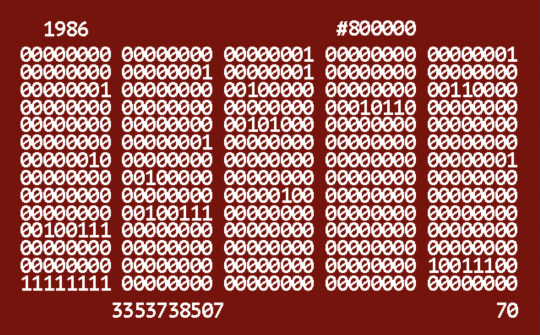
00 00 01 00 01 00 01 01 00 00 01 00 20 00 30 00 00 00 16 00 00 00 28 00 00 00 01 00 00 00 02 00 00 00 01 00 20 00 00 00 00 00 04 00 00 00 27 00 00 00 27 00 00 00 00 00 00 00 00 00 00 00 00 00 9c ff 00 00 00 00
A single red (0x800000) pixel.
Represents the frustration that comes from being confused by something you really want to understand.
An ICO file created for a Toshiba T3100, running on an Intel 80286 @ 8 Mhz, with a built in 640x400 gas plasma display, running MS-DOS 2.11 and Windows 1.02, with a 1200 bps modem, 5MB of RAM and a 10MB hard disk drive
~
0x05.gif

47 49 46 38 37 61 01 00 01 00 f0 00 00 00 00 80 00 00 00 21 f9 04 00 00 00 00 00 2c 00 00 00 00 01 00 01 00 00 02 02 44 01 00 3b 0a
A single blue (0x000080) pixel.
Represents the feeling you get when you finally start to understand something.
A GIF file for a Macintosh II running Apple Macintosh System Software Update 5.0 on a Motorola 68020 CPU @ 16 MHz with 8MB of RAM, a 40MB hard drive, and a 13" AppleColor High-Resolution RGB Monitor at 640x480, with the optional 1200bps Apple Personal Modem.
~
0x06.tiff
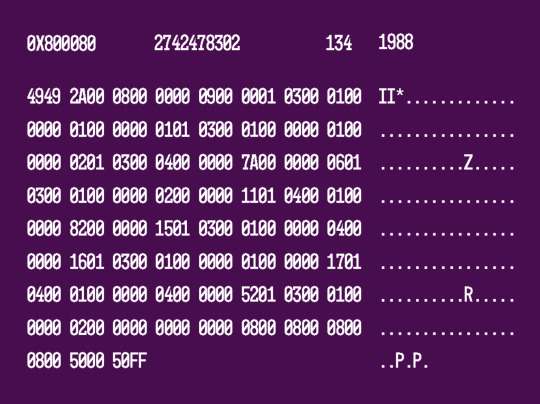
4 9 4 9 2 a 0 0 0 8 0 0 0 0 0 0 0 9 0 0 0 0 0 1 0 3 0 0 0 1 0 0 0 0 0 0 0 1 0 0 0 0 0 0 0 1 0 1 0 3 0 0 0 1 0 0 0 0 0 0 0 1 0 0 0 0 0 0 0 2 0 1 0 3 0 0 0 4 0 0 0 0 0 0 7 a 0 0 0 0 0 0 0 6 0 1 0 3 0 0 0 1 0 0 0 0 0 0 0 2 0 0 0 0 0 0 1 1 0 1 0 4 0 0 0 1 0 0 0 0 0 0 8 2 0 0 0 0 0 0 1 5 0 1 0 3 0 0 0 1 0 0 0 0 0 0 0 4 0 0 0 0 0 0 1 6 0 1 0 3 0 0 0 1 0 0 0 0 0 0 0 1 0 0 0 0 0 0 1 7 0 1 0 4 0 0 0 1 0 0 0 0 0 0 0 4 0 0 0 0 0 0 5 2 0 1 0 3 0 0 0 1 0 0 0 0 0 0 0 2 0 0 0 0 0 0 0 0 0 0 0 0 0 0 0 8 0 0 0 8 0 0 0 8 0 0 0 8 0 0 5 0 0 0 5 0 f f
A single purple (0x800080) pixel.
Represents the ability to organise thoughts into concepts.
A TIFF file for an IBM Personal System/2 (PS/2) with a 32-bit Intel 80386DX @ 25 MHz and 16 MHz 80387 maths coprocessor, 8MB of RAM, with an IBM PS/2 VGA Display Adapter at 1024x768, a 70MB ESDI hard drive, a 3.5" 1440 KB Mitsubishi floppy drive, a Creative Labs SoundBlaster 1.0 and a 9600bps Hayes Smartmodem, connected to an HP ScanJet scanner, running MS-DOS 3.31 and Windows/386 2.01
~
0x07.xpm
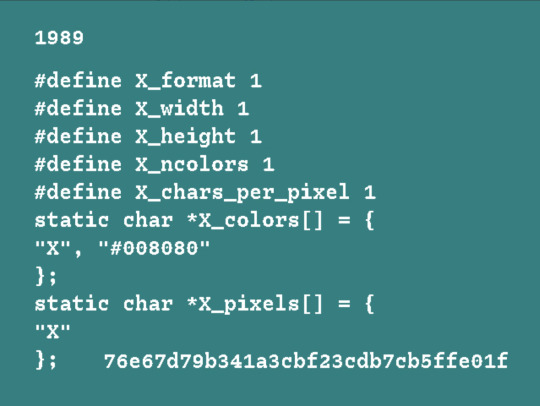
23646566696e6520585f666f726d6174 20310a23646566696e6520585f776964 746820310a23646566696e6520585f68 656967687420310a23646566696e6520 585f6e636f6c6f727320310a23646566 696e6520585f63686172735f7065725f 706978656c20310a7374617469632063 686172202a585f636f6c6f72735b5d20 3d207b0a2258222c2022233030383038 30220a7d3b0a73746174696320636861 72202a585f706978656c735b5d203d20 7b0a2258220a7d3b0a
A single teal (0x008080) pixel.
Represents the ability to turn concepts into code.
An XPM (v1) file for a Toshiba T3200SX/120 portable computer, with an Intel 80386SX @ 16 MHz, the 120 MB hard drive upgrade, 13 MB of RAM, a 3.5" 1.44 MB floppy drive, the optional hayes compatible modem, a TD80 external tape drive, the Expansion chassis and Expansion interface card, running X11R4 on top of any compatible Unix distribution (e.g. System V) connected to an external VGA color monitor set to 640x480
~
0x08.ps
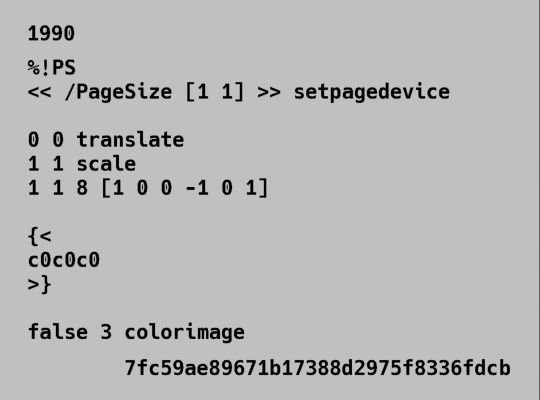
53502125 203c3c0a 6761502f 7a695365 315b2065 205d3120 73203e3e 61707465 65646567 65636976 20300a0a 72742030 6c736e61 0a657461 20312031 6c616373 20310a65 20382031 3020315b 2d203020 20302031 0a0a5d31 630a3c7b 63306330 7d3e0a30 61660a0a 2065736c 6f632033 69726f6c 6567616d 0a
A single silver (#0c0c0c) pixel.
Represents the ability to manipulate pixels.
A PostScript file for the NeXTcube running on a Motorola 68040 @ 25 MHz with 64MB of RAM, a 2.88MB floppy drive and a 1.4GB SCSI hard drive connected to a NeXT MegaPixel Display at 1120x832 resolution, with an external ZyXel 9600bps modem
~
0x09.pbm

01010000 00110110 00001010 00110001 00001010 00110001 00001010 00110010 00110101 00110101 00001010 10000000 10000000 10000000
A single grey (#808080) pixel.
Represents the ability to make money from software.
Portable bitmap file for an Apple Powerbook 170 with a 640x400 display, the optional 2400bps modem addon in the expansion port, 8MB of RAM, an 80MB hard disk drive, on a Motorola 68030 CPU and Motorola 68882 FPU, both at 25 MHz, running System 7, with PhotoShop 2.0 and a PBM plugin
~
0x0a.jpg

ffd8 ffdb 0043 0003 0202 0202 0203 0202 0203 0303 0304 0604 0404 0404 0806 0605 0609 080a 0a09 0809 090a 0c0f 0c0a 0b0e 0b09 090d 110d 0e0f 1010 1110 0a0c 1213 1210 130f 1010 10ff db00 4301 0303 0304 0304 0804 0408 100b 090b 1010 1010 1010 1010 1010 1010 1010 1010 1010 1010 1010 1010 1010 1010 1010 1010 1010 1010 1010 1010 1010 1010 1010 1010 1010 ffc0 0011 0800 0100 0103 0111 0002 1101 0311 01ff c400 1400 0100 0000 0000 0000 0000 0000 0000 0000 08ff c400 1410 0100 0000 0000 0000 0000 0000 0000 0000 00ff c400 1501 0101 0000 0000 0000 0000 0000 0000 0000 0709 ffc4 0014 1101 0000 0000 0000 0000 0000 0000 0000 0000 ffda 000c 0301 0002 1103 1100 3f00 3a03 154d ffd9
A bright red (#ff0000) pixel.
Represents the feeling you get when you just can't quite figure out the problem you're trying to solve.
A JPEG for a Dell 486DX2 @ 50MHz, with a 230MB hard disk drive, a floppy drive, 16MB of memory, a 14" 1024x768 display, and an external SupraFAX 14,400bps modem
~
0x0b.psd
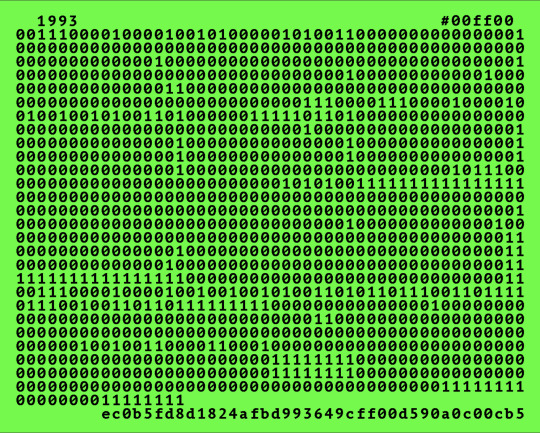
OEJQUwABAAAAAAA AAAQAAAABAAAAAQ AIAAMAAAAAAAAAH DhCSU0D7QAAAAAA EAABAAEAAQABAAE AAQABAAEAAABcAA AAVP//AAAAAAAAA AAAAAABAAAAAQAE AAAAAAADAAEAAAA DAAIAAAAD//8AAA ADOEJJTW5vcm3/A AEAAAAADAAAAAAA AAAAAkwxAAAAAAA A/wAAAAAA/wAAAA AAAAD/AP8=
A bright green (#00ff00) pixel.
Represents the feeling you get when you finally figure out a problem you've been stuck on.
Created for PhotoShop 2.5 on a Compaq Deskpro 5/60M with 24MB of RAM, a 510MB hard disk drive, an Intel Pentium processor @ 60MHz running Windows for Workgroups 3.11, and a 1MB Diamond Multimedia graphics card connected to a 19" monitor set to 1280x1024 (16 bit)
~
0x0c.png
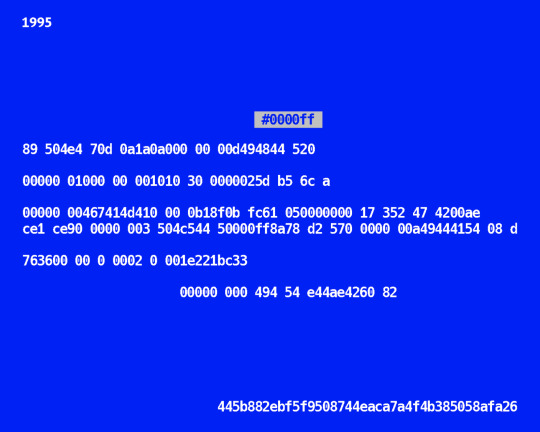
0000: 8950 4e47 0d0a 1a0a .PNG.... 0008: 0000 000d 4948 4452 ....IHDR 0016: 0000 0001 0000 0001 ........ 0024: 0103 0000 0025 db56 .....%.V 0032: ca00 0000 0467 414d .....gAM 0040: 4100 00b1 8f0b fc61 A......a 0048: 0500 0000 0173 5247 .....sRG 0056: 4200 aece 1ce9 0000 B....... 0064: 0003 504c 5445 0000 ..PLTE.. 0072: ff8a 78d2 5700 0000 ..x.W... 0080: 0a49 4441 5408 d763 .IDAT..c 0088: 6000 0000 0200 01e2 `....... 0096: 21bc 3300 0000 0049 !.3....I 0104: 454e 44ae 4260 82 END.B`.
A bright blue (#0000ff) pixel.
Represents the ability to recover from failure.
Created for a Compaq Deskpro XL, on an Intel Pentium processor @ 90MHz, with 32MB of RAM, a 1GB SCSI hard disk drive, an internal SCSI HP SureStore CD-Writer, running MS-DOS 6.22 and Windows 95, with a 2MB Matrox Millennium PCI Graphics Card connected to an Energy Star certified 17" NEC 1280x1024 CRT display, and an external US Robotics Sportster 28,800bps V.34 data/fax modem
~
0x0d.svg
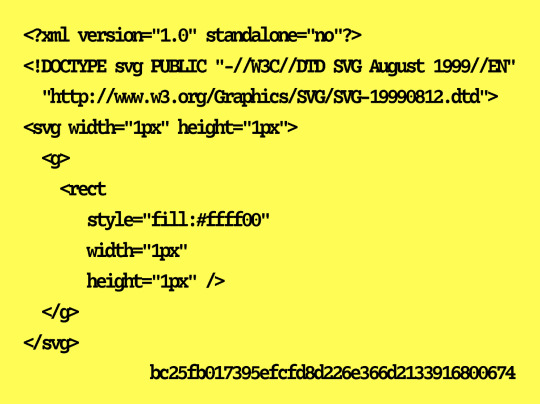
3c3f786d6c20 76657273696f 6e3d 2231 2e3022207374 616e64616c6f 6e65 3d22 6e6f223f3e0a 3c21444f4354 5950 4520 737667205055 424c49432022 2d2f 2f57 33432f2f4454 442053564720 4175 6775 737420313939 392f2f454e22 0a20 2022 687474703a2f 2f7777772e77 332e 6f72 672f47726170 686963732f53 5647 2f53 56472d313939 39303831322e 6474 6422 3e0a3c737667 207769647468 3d22 3170 782220686569 6768743d2231 7078 223e 0a20203c673e 0a202020203c 7265 6374 0a2020202020 20207374796c 653d 2266 696c6c3a2366 666666303022 0a20 2020 202020207769 6474683d2231 7078 220a 202020202020 206865696768 743d 2231 707822202f3e 0a20203c2f67 3e0a 3c2f 7376673e0a
A bright yellow (0xffff00) pixel.
Represents trying something new and unexpectedly loving it.
Created for an Intel Pentium 3 600, 384MB of RAM, with a 13.5GB hard disk drive, a Microsoft Intellimouse, an internal DVD-ROM drive, and an NVidia GeForce 256 connected to a Sony CDP-E500 21" CRT Monitor, set to 2048 x 1536, with an external iomega ZIP drive and a 56kbps US Robotics modem running Windows '98
~
0x0e.html
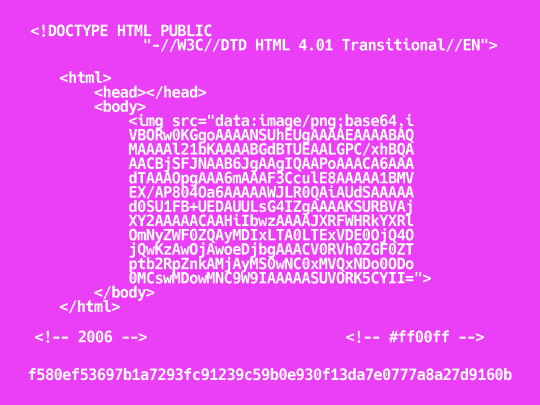
iVBORw0KGgoAAAANSUhEUgAAAAEAAAABA QMAAAAl21bKAAAABGdBTUEAALGPC/xhBQ AAACBjSFJNAAB6JgAAgIQAAPoAAACA6AA AdTAAAOpgAAA6mAAAF3CculE8AAAAA1BM VEX/AP804Oa6AAAAAWJLR0QAiAUdSAAAA Ad0SU1FB+UEDAUULsG4IZgAAAAKSURBVA jXY2AAAAACAAHiIbwzAAAAJXRFWHRkYXR lOmNyZWF0ZQAyMDIxLTA0LTExVDE0OjQ4 OjQwKzAwOjAwoeDjbgAAACV0RVh0ZGF0Z Tptb2RpZnkAMjAyMS0wNC0xMVQxNDo0OD o0MCswMDowMNC9W9IAAAAASUVORK5CYII=
A single magenta (#ff00ff) pixel.
Represents knowing what you want to do, and diving headfirst into it.
An encoded data-uri inside an HTML page for Firefox on an AMD Athlon 64 X2 4200+ CPU, with a 750GB Seagate Barracuda Hard drive, a 1 GB NVIDIA GeForce 7950 GX2, a SoundBlaster Audigy 2 and 4GB of RAM, connected to a 2048 x 1536 display running Windows Vista, with an ethernet cable connected directly to an ADSL modem
~
0x0f.webp
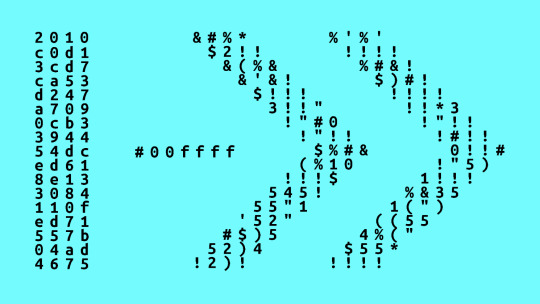
524946463c00 0000 5745 425056503820 3000 0000 d001009d012a 0100 0100 02003425a002 74ba 01f8 0003b000fef0 45df ff1b b7186fc177ff 238f e471 fc8e3ff90c80 0000
A single teal (0x00ffff) pixel.
Represents time moving faster when you're in the zone.
A WebP file for a Dell XPS 15 with 1080p display, 16GB of RAM, and a 2.2GHz Intel Core i7 processor, a 1TB 5,400rpm hard drive, and an Nvidia GeForce GTX 1050 Ti Max-Q GPU with 4GB of VRAM, running Ubuntu Linux 10.04, connected to any router via WiFi
~
0x10.flif
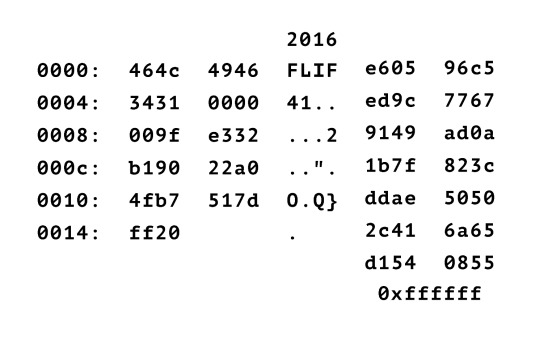
01000110 01001100 01001001 01000110 00110100 00110001 00000000 00000000 00000000 10011111 11100011 00110010 10110001 10010000 00100010 10100000 01001111 10110111 01010001 01111101 11111111 00100000
A single white (#ffffff) pixel.
Represents the fact that we now live in a world where there is more metadata than actual data.
A FLIF file for a MacBook Pro (Retina, 13-inch, Early 2015) with a 2,7 GHz Dual-Core Intel Core i5, 8GB of RAM and a 256GB SSD drive running MacOS
~
0x11.jxl

00: ff0a 0010 b012 0810 ........ 08: 1000 1c00 4b12 8502 ....K... 10: 8524 0c .$.
A blank canvas. The future, transparency, and the great unknown; filled with endless possibility.
An empty JPEG-XL file created for any device that can render it, connected to a 4K (3840x2160) or better display.
~~~
i hope you enjoyed the journey, you can see the full collection on opensea
#nft#nftcollection#cryptoart#nftcommunity#ethereum#history#nftartist#nftart#xterm-16color#0x10#ethereum nfts#history lesson
29 notes
·
View notes
Text



ibM 5150 pc witH iBm ModEL F kEyboARd, iBm 5153 Pc COLoR diSpLAy, iBm 5152 Pc pRiNteR ANd pc-Dos 3.3.
46 notes
·
View notes
Photo

On this day 38 years ago IBM introduced the "personal computer" also known as the Model 5150. It ran on a 4.77 MHZ Intel 8088 microprocessor and DOS 1.0. Happy birthday to the PC!
2 notes
·
View notes
Text
Review buku - Play Nice But Win

Buku yang akan saya bahas kali ini merupakan buku kedua tulisan Michael Dell, pendiri sekaligus CEO dari perusahaan Dell Technologies. Buku pertamanya berjudul "Direct from Dell" yang diterbitkan pada tahun 1998, bercerita mengenai perjalanan sang founder secara ringkas dari memulai membuat perusahaan dari kamar asramanya selama berkuliah dan lebih banyak membahas pencarian model bisnis ataupun jati diri dari perusahaan dan sang penemu. Di buku keduanya ini, penulis membuat tulisan yang jauh lebih personal dengan pola pikir yang jauh lebih dewasa, ia menceritakan beberapa peristiwa dengan lebih detail, dari masa kecilnya yang berasal dari keluarga berkecukupan, ayahnya yang seorang Dokter dan ibunya yang merupakan ibu rumah tangga dan bekerja paruh waktu sebagai agen properti, membuat ketiga anaknya mendapatkan pendidikan yang baik semasa kecilnya.
Pada masa remaja-nya Michael Dell memiliki ketertarikan terhadap dunia Komputer, pada saat itu model komputer yang sangat terkenal adalah Apple II, dengan berbekal uang hasil kerja paruh waktunya, Michael Dell meminta bantuan dari Ayahnya untuk mendapatkan komputer tersebut, yang akhirnya menjadi pembuka jalan ke dunia yang baru untuknya. Setelah bergabung kedalam sebuah komunitas, Michael Dell semakin memahami bahwa perangkat Apple II yang dimilikinya memiliki banyak sekali potensi, dengan menggunakan bahasa pemrograman, ia bisa melakukan atau mewujudkan banyak hal, minatnya ini membawanya terus mempelajari dunia komputer, hingga pada suatu hari IBM mengeluarkan komputer miliknya dengan nama 5150, inilah cikal bakal PC yang kita kenal saat ini, 5150 sudah menggunakan prosesor keluaran Intel dan juga menggunakan OS (Operating System) buatan Microsoft, yaitu MS-DOS. Ketertarikannya terhadap piranti Apple sekejap teralihkan kepada PC milik IBM tersebut dan setelah mendapatkan PC tersebut, ia mencoba mempelajari keseluruhan sistemnya dan akhirnya menyadari betapa besar potensi yang ada di perangkat milik IBM tersebut, karena berbeda dengan perangkat buatan Apple yang setiap sudutnya dibuat oleh Apple, IBM menggunakan banyak bagian dari berbagai macam brand, hal ini membuka cakrawala baru bagi Michael Dell.
Suatu ketia ia menemukan cara untuk meng-upgrade PC miliknya sehingga menjadi lebih cepat, lebih banyak kapasitas penyimpanan dan lainnya. Melalui mulut ke mulut, ia memulai cikal bakal perusahaannya, ia mencoba memodifikasi mesin buatan IBM tersebut menjadi jauh lebih powerful, perlahan tapi pasti, namanya mulai dikenal sebagai ahli modifikasi PC, meskipun pada saat itu ia masih anak SMA, tapi minatnya terhadap komputer dan bisnis makin lama makin tidak terbendung.
Hingga pada masa awal perkuliahannya, Dell menjadi terlalu fokus terhadap bisnisnya ini sehingga ia hampir tidak pernah mengikuti perkuliahan, orang tuanya yang mengetahui hal tersebut, sempat memberikan peringatan, namun gejolak dan naluri bisnisnya mengarahkan ia untuk terus menjalankan bisnisnya, meskipun harus membuat kedua orang tuanya kebingungan dengan pilihan hidupnya tersebut.
Meskipun perjalanannya tidak selalu mulus, Dell berhasil membesarkan usahanya dengan mengajak kerja sama orang-orang profesional yang memiliki usia jauh diatasnya, lika-liku perjalanan bisnisnya disajikan secara menarik dalam setiap bagian buku ini, mulai dari pengalaman pahit dituntut oleh IBM karena melanggar hak paten milik IBM, mencari pinjaman modal dari Investor, memperbesar operasional perusahaan hingga ketingkat global, mempersiapkan perusahaan untuk melantai di Bursa saham (IPO), hingga berusaha untuk mengambil alih seluruh sahamnya kembali, membeli dan melakukan merger dengan perusahaan raksasa EMC dan VMware, hingga akhirnya kembali melantai di bursa saham, semua bagian tersebut tertuang dalam buku "Play Nice But Win", menjadikan buku ini cukup asik untuk dibaca, terutama bagi para profesional ataupun yang tertarik untuk terjun ke dunia bisnis, karena masalah yang ia hadapi sebetulnya relevan dengan kegiatan sehari-hari yang akan dihadapi oleh para pebisnis, menghadapi keberadaan kompetitor, memuaskan para pemegang saham sekaligus membawa kepentingan perusahaan, dan lain sebagainya.
Buku ini menyenangkan, karena dengan membacanya kita bisa mengetahui bahwa para tokoh teknologi ternama, sebetulnya pada masa awal pendirian perusahaan, banyak yang saling bersinggungan dan saling membantu sebagai partner, menjadikan perusahaan masing-masing terus bertumbuh, melihat kisah antara Steve Jobs dan Michael Dell yang sempat saling sindir dengan kampanye ataupun pernyataan di media, namun di belakang layar sebetulnya kedua orang tersebut merupakan sahabat yang sempat saling bertukar pikiran mengenai bisnis, dan lain sebagainya. Selamat membaca dan semoga bermanfaat!
0 notes
Text
Ο IBM PC γίνεται 40 ετών
Ο IBM PC γίνεται 40 ετών
Η IBM μπήκε σχετικά αργά στο παιχνίδι των προσωπικών υπολογιστών με το Model 5150 ή απλά IBM PC. Η Commodore και η Apple ουσιαστικά κυριαρχούσαν στην αγορά των λεγόμενων «microcomputer» από τα τέλη της δεκαετίας του 1970 έως και τις αρχές της δεκαετίας τους 1980. Αντίθετα, η Big Blue, όπως είναι το παρατσούκλι της IBM,… The post Ο IBM PC γίνεται 40 ετών appeared first on Fibernews. Το Διαβάσαμε Ο…

View On WordPress
0 notes
Text
File 1: The PC/XT

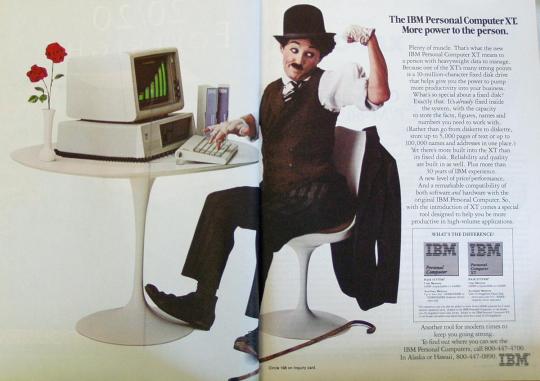
Where it all began, more or less
This is the IBM 5160 PC/XT, the 1983 follow-up on 1981's IBM 5150 PC. By itself the 5160 was largely an iterative advancement on the 5150 PC, most notably trading the earlier model's little-used cassette connector for three more ISA expansion slots totalling at eight versus the PC's five. The PC/XT's BIOS also had some enhancements meant to make hard disk I/O easier, but these were also integrated into later PC BIOS revisions. The minority of the changes the XT brought to the table are nonetheless significant; They mark the point where Intel's x86 (and later x86-64) architecture slowly started to become codified as a standard in computing. To this day, your average Intel or AMD CPU-based computer can run code meant for the PC 5150 and 5160 unaltered (with certain caveats such as needing a MS-DOS or FreeDOS boot floppy). Much like it's precursor, the PC/XT is powered by a 4.77MHz Intel 8088 CPU and can push up to 640 kilobytes of RAM (but in the early days, maxing it out would have been extremely unusual). I'd been obsessed with these systems for a fairly long time, considering the acquisition of one a milestone for my computer collection.

In November of 2017, something caught my eye: A man downstate near Peoria selling a IBM PC/XT in pretty darn fine shape with one floppy drive and one hard drive, complete with a Amdek data display and a original IBM Personal Computer keyboard¹. All that kit, and the guy was at a fair price, to boot! I'd wanted one of these for more than a decade and I had a decent surplus of cash thanks to paid time off having paid out at work a few days earlier, so I'd be an absolute moron to not have jumped on it. The only catch? Pickup was local only, and I didn't have a car at the time. This would be an immediate and pressing issue, but it turned out the man came up to Chicagoland regularly and had business in my neck of the world anyways. At that point, I could have borrowed a ride for a short distance run to the meeting place he'd proposed, a furniture outlet two towns over, pretty easily. It was a date with destiny.

So it went. A few days later, I rolled up and parked at said shop. The machine's seller turned out to be an older fellow who greatly resembled Joseph Joestar (Pictured above) to a disturbing degree. The actual exchange went pretty smoothly. I went in the shop and ate some awful, awful (yet satiating) meatballs. The trip home was pretty uneventful. So far, so good...and I was fresh off the restoration of a IBM 5170 PC/AT I’d picked up at VCFMW, so at the time I figured this one wouldn't hold many surprises. Besides, the IBM PC was the standard most people imitated at the time if they went for MS-DOS. It'd have to be a breeze, wouldn't it? This theory wouldn't hold water, and soon I'd find myself surprised by the fact that it did, in fact, hold many surprises.
“Hey, wanna hear the most annoying sound in the world?"
When I made it home, I slapped it on my workbench and popped it open for an initial inspection. The machine had obviously seen some upgrades over it's lifespan: The installation of an aftermarket power supply, a Hercules monochrome graphics card, a 3600RPM 30MB Seagate ST238 hard drive, a Tecmar Captain Real Time Clock/Serial/Parallel/Memory board, and a Scientific Solutions DADI/O card. The latter most card was the most curious in retrospect, since it hinted at the machine's background in ways pretty much nothing else could. I doubt I'll ever find out exactly what that background was since it didn't occur to me to ask the seller at the time, but the hint it represents is fascinating since that's not something you'd think you'd find in an old farmer type's WordStar 4 machine...which, by all means, this thing had otherwise appeared to be to this point.


It's worth mentioning here that the hard drive I'd previously alluded to was a model using the MFM interface, the late '70s - mid '80s precursor to the more modern IDE/PATA and the SATA interface seen in pretty much every modern computer. MFM drives are fickle but impressive beasts, with their controller hardware on a separate expansion card and little brains of their own. They're slow, they're loud, they're clunky and they're an awe to behold in spite of (or perhaps because of) all that. They have actual, honest to god stepper motors and mechanical brakes. When they work, they're impressive as hell but...they often don't. At least, I've found more dead ones than I've found live ones. Naturally, when I first turned the machine on as-is to kick off the smoke test process and assess precisely what I'd need to fix up, I heard said MFM hard disk warm up... followed by a shrill, piercing dragging noise that could only be the hard disk's read/write head burying itself in one of the hard disk's platters. That lack of smarts inherent to MFM hardware I'd alluded to had come back to haunt this system, since MFM drives typically don't know to automatically park the head somewhere catastrophe is less likely to strike unless the command is issued manually by the user. It pretty obviously wasn't parked before the machine was put into storage, so at some point in time the machine was jostled enough to put the head somewhere it'd thrash the drive as soon as it was given power again. In layman's terms, the thing was toast. Well, shit. I like to keep hardware period accurate where I can, but MFM drives are prone to wild price fluctuations and you often have to gamble on untested drives when buying used due to how difficult they can be to test. Thankfully, a relatively practical solution that cuts out some of the uncertainty exists and I'd had good luck with it on previous projects with dead drives: An IDE controller card loaded with the XT-IDE Universal BIOS. Usage of an IDE card would allow me to hook up something more readily available (Such as an old 80gb drive or even a CompactFlash memory card), and usage of the XT-IDE BIOS would make booting simpler since that would mean not having to gamble on the card's own BIOS (or lack thereof). The pair are a pretty common solution to this sort of boondoggle to the point that there are open-source card designs readily available for purchase from many sellers, including Glitchworks , whom I've relied on in the past quite a bit and from whom I wound up purchasing a Revision 4 XT-IDE card from for this project. I also snagged a nice 64mb Cisco cF card off ebay, which would pretty much have to be bootable since it was formerly boot media for some smart network switch or something that's outside the scope of this article.
Hey Mr. Postman, Man me a Post
Time passed, the U.S. Postal Service did its thing, and I planned and prototyped what the final IBM DOS install would look like using PCEm. I was initially targeting IBM PC-DOS 2.11 since that version of DOS is what the PC-XT shipped with, but decided 3.30 would be a better choice since it'd fit the machine's upgrade history and most MS-DOS software out there expects 3.0 at a minimum. DOS 3.0 through 3.30 were essentially to DOS what Windows XP would later be to Windows in terms of longevity.

I also attempted to remove some of the light rust from atop the case using the tried-and-true method of vinegar and tinfoil. I succeeded at getting rid of a fair bit of the corrosion, but also took some of the paint with it; that paint used on the IBM PC line's chassis is a textured, unusual spatter coat job that's both a pain and expensive to reproduce to the point that it's just not worth it to spray paint. Typically people just accept the blemishes or find a replacement case altogether. This exact thing had happened with my PC/AT previously, so I don't really know what I was expecting to happen. Thankfully, the monitor mostly obscures the blemishes.

I also wound up attempting to service the 5 1/4" floppy drive at this time, which was in dire need of some care and plagued by mechanical issues. The read and write head wouldn't work reliably for anything and the movement of said head was almost comically stiff. Getting things cleaned up was superficially simple enough; most of the time all that's needed is cotton swabs and some isopropyl. Clean the read/write head, take off the old, gunky, dusty grease on the drive rails, and you're solid. Regreasing the rails so that the head could move freely also went simply enough, merely needing some white lithium grease on the previously cleaned rails. Using my testing boot media I got the system booted into DOS using a floppy after the cleaning; While 360kb of space wasn't nearly enough this wasn't meant to be the final setup. Cramped, sure, but it sufficed for testing. By all means, the drive seemed to be working fine now since it superficially read and wrote fine while also formatting without errors...and if anything was wrong, it sure wasn't obvious to me or the system itself. Eventually the XT-IDE card made it in. I slotted it in, hooked up my cF-IDE adapter, and set up DOS onto the drive. When I tried to boot off the hard disk the first time, though, I was greeted by a screen full of garbage and rancorous beeping from the system's speaker. Something was wrong, and I had no idea what since typically the setup process for XT-IDE cards is pretty braindead once it's assembled properly and in the system. Repeated attempts at re-installation of both the card and the operating systems yielded no changes, and even taking the XT-IDE card and cF card out altogether for a transplant install in my PC/AT (my "known good" testing system) lead to nothing but more garbage on what is otherwise a computer willing to take whatever absurdity I throw at it with grace and gusto. Trying different floppy disk install media and different DOS versions did nothing to fix the corruption issues the thing was having, and it didn't like different cF cards either. What was happening? On pointers from Glitch himself and some other friends on a chain of IRC channels I hung around, I ran diagnostics of various types, including pulling all the installed expansion cards one-by-one and testing to rule out conflicts. There were none, and by all means pretty much every part of the system but the card checked out fine.
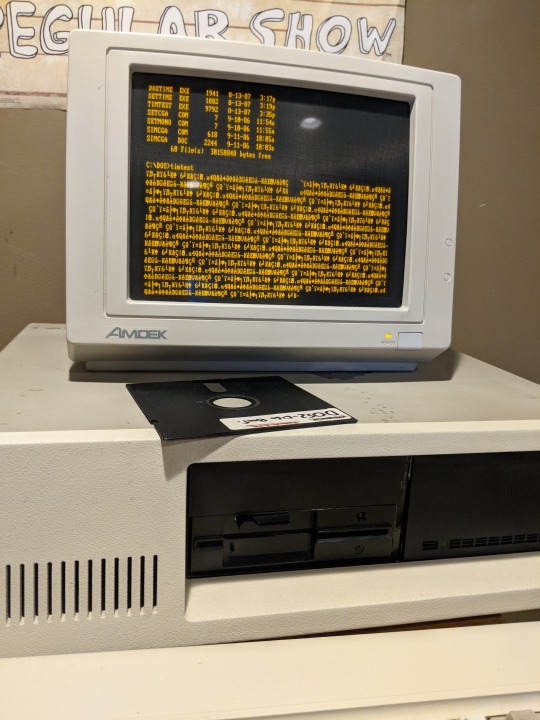
It turned out my card had a 573 latch go bad due to an issue with a bad shipment of ICs from a part supplier on Glitchworks' end, so with help from Glitch, the namesake and head honcho of the company, that all was simple enough to sort out; the board had the bad IC swapped out in no time at all. Once that all was in order, I found myself facing mounting frustration as the system still didn't want to boot off the cF card (but just hanging on boot with no errors or anything at all instead of spewing garbage all over the screen now), but I noticed it sometimes - yet inconsistently - did like mechanical hard disks and more robust IDE DOMs. Programs also experienced random corruption issues, too. I wasn't in the clear quite yet; I had a weak step in the install process to find which was corrupting DOS installs left and right.

My only clue? Transplanting the card to the PC/AT and installing DOS from there worked perfectly fine, even after moving the card back to the PC/XT. The PC/AT's boot card also worked just fine in the XT. That suggested that whatever the issue was, it was isolated to the PC/XT's input/output facilities specifically. The XT-IDE card itself actually was perfectly fine now and the similar symptoms to that of the bad latch were mere red herrings. It took me a while (and some shouting at from friends) to make the connection, but eventually I came to the conclusion that I should give the floppy drive a one-over using CheckIt, a personal go-to software suite for diagnostics on DOS systems. Lo and behold the floppy drive was generating absurd amounts of read errors, and at that point they could only be caused by capacitor issues (which would be fairly serviceable to fix but not immediately worth doing) or alignment issues (in which case the drive might as well be scrap²). It was easier just to not use the 360k drive. With the knowledge that the floppy drive was not to be trusted at all under my belt as well as the knowledge that any operating system installation should be done from the PC/AT, I proceeded to take another crack at things. I wound up with the PC/XT's Cisco CompactFlash card booting fine in the PC/AT but not the PC/XT, and the PC/AT's Compactflash card (a cheaper SanDisk card) booting fine in both. I figured I'd try swapping the cards out in full and this resulted in both machines working perfectly, as the PC/AT was more than happy with the theoretically nicer Cisco card. CompactFlash media can be fickle like that, but considering the SanDisk card is a significantly cheaper card meant for cameras yet proved more to the PC/XT's taste than a card expressly meant to be used as boot media is just bizarre; However at that point I couldn't be bothered to question things further since they well and truly worked from then on out. That wrapped up the last of the technical hurdles, and I was free to work on the machine at the software end of things.
AND REVERSI!
File transfer would be downright trivial with the cF card as my fixed disk, being just a matter of pulling the card from it's slot in the rear of the system and shuttling it over to my desktop in order to add programs or files. That wouldn't be a luxury I'd have with the DOM, in which case I'd have to deal with comparatively slow exchanges using FASTLYNX. I decided to stick to IBM DOS 3.30 with XTREE 2.0, a typical DOS shell and one that might have realistically ben in use in the machine's heyday. I also got Windows 1.01 installed, but without a mouse it's somewhat awkward to use. I can get a mean game of Reversi, Windows 1.01 through 2.11's built in game, going though.

Since that last bit of struggle with storage, everything has been essentially silk smooth. It was a months-long ride of trial and error, but in the end I finally got the working PC/XT I'd been wanting for years. Brutalist and built like a tank yet oddly attractive in that '80s way, the machine is an absolute blast to both use and behold. I can easily see it remaining the keystone of my collection for some time to come. There's still some stuff i'd like to sort out and some experiments I'd like to carry out (especially in regards to that Hercules graphics card I mentioned, which is worth a write-up in it's own right), but for now I can rest easy knowing that I've managed to get it back in shape in spite of what felt like three months of non-stop obstacles.

1: The IBM PC 5150 and PC/XT 5160 keyboard microcontroller used a much different protocol for input and output on a hardware and software level than the one in the later IBM 5170 PC/AT and onward would use. This means that if you scalp a PC or PC/XT-friendly keyboard (or any other legacy system's keyboard, on that thought) for the neato mechanical switches you're going to have an extremely difficult time finding a replacement. Don't do that; Consider a more modern mechanical keyboard instead. They're cheaper, just as good, and you don't potentially irreversibly gore a computer that way.
2: Alignment issues are dependent on blind luck or stupidly expensive and rare specialty equipment to fix. Even then, you still need a bit of blind luck.
36 notes
·
View notes
Text
Zašto vladajući vole standardizovane škole?

Tokom novembra 2016. godine, u okviru Moodle sistema za učenje na daljinu[1], Ministarstvo prosvete, nauke i tehnološkog razvoja Republike Srbije izvodilo je veliku onlajn obuku za primenu standarda namenjenu nastavnicima opšteobrazovnih predmeta u gimnazijama. ( Sajt je, kako se navodi, nastao kroz projekat „Razvionica“ koji je iz predpristupnih fondova, naravno, finansirala / kreditirala Evropska unija.[2] )
Obuka je podeljena na više Moodle modula, pa je predviđeno da se u okviru prvog izučavaju “Standardi postignuća – karika u osiguranju kvaliteta obrazovanja”.
Sami Amerikanci muku muče sa svojim aktuelnim kurikulumom u osnovnoj školi, koji je podbacio na svim poljima, te zahtevaju promene, promene, promene… “Vreme je da se preosmisli američki obrazovni sistem”, upozorava već izvesno vreme prestižni ekonomski magazin Harvard Business Review.[3] Začuđuje, stoga, što se u Evropi trenutno (pre)prodaje stari / preinačeni predlog - standardizacija. To je koncept iz zlatnog doba industrijskog kapitalizma, odnosno Fordizma, kada je za svemoćno tržište bilo dovoljno proizvesti dve različite marke automobila, da bi se kod uzornog i ornog kupca osigurao privid izbora. Proizvodna traka prirodno iziskuje i standardizaciju opreme, radnog vremena… i na kraju - samih ljudi. Standardizacija ljudi se prirodno najefikasnije postiže kroz standardno / obavezno obrazovanje u standardizovanoj školi.
Danas je tržišna situacija daleko kompleksnija. Razmaženi potrošač je ohrabren da gaji svoj „jedinstven ukus“ te neizostavno zahteva veliku diferencijaciju robne ponude pa je proizvodnja (dalekoistočna) prinuđena da svakodnevno osluškuje hirovitog kupca koji za svoj novac zapravo priželjkuje nešto poput autentičnog identiteta koji mu sa druge strane, hvala šarenolikim potrošačkim nebesima, uporno i neprekidno izmiče. O standardizaciji bilo čega, kao prevaziđenom konceptu, više nema ni govora. Svi dvovekovni standardi su zapravo na dnevnom redu za sistematsko urušavanje. Svakodnevno svedočimo agresivnoj propagandi u kojoj se tvrdi da više ne postoji standardno radno mesto, radno vreme, zarada. „Obavljanje više poslova u isto vreme i rad u fleksibilnijim uslovima su ono što poslodavci traže.“[4] Svim snagama se razara standardna struktura porodice, ruši se razlika između slobodnog i radnog vremena, između mladih i starih, što je česta tema mnogih istraživanja i izdanja nakon pretvaranja elektronskog računara u robu široke potrošnje. Jedan od najuspešnijih / najprodavanijih pionirskih modela personalnih računara, 5150 PC firme IBM, lansiran je na tržištu 1981. godine, da bi već naredne godine priznati teoretičar medija, publicista, kritičar i istraživač obrazovanja, Nil Postman, objavio knjigu simptomatičnog naslova “Nestanak detinjstva”[5]. Čak se i standardna prirodna podela na polove polako ali sigurno minira i potire.
Otkud onda standardi u novoj milenijumskoj školi? Radi li se o još jednoj ironiji i samovolji vlastodržaca ili je nešto daleko ozbiljnije u pitanju? Primetićemo da se istovremeno kroz školu zagovara koncept “turbo” individualizacije učenika i učenica. Svako u odeljenju ima svoje sasvim specifične potrebe, jedinstven ritam usvajanja znanja, poseban odnos prema vršnjacima, vaspitačima i edukaciji… Sve to u svakodnevnom radu mora uzimati u obzir svaki nastavnik / nastavnica za svakog učenika / učenicu ponaosob. Insistira se čak na ažurnom vođenju neverovatno detaljne pedagoške dokumentacije za svakog đaka i (… odgovarajući ženski rod mi nije poznat).

Nalazimo se pred ozbiljnom dilemom. Da li je jedinstvenost / neponovljivost (limited edition brand) samo privid i šarena glazura a standardizacija još uvek neprikosnovena skrivena suština savremenog / virtuelnog društva? Nije, naime, nikakva tajna da se najlakše upravlja armijom klonova koji u određenim, strogo omeđenim granicama, neguju dozvoljeni privid jedinstvenog identiteta. Najjednostavnije za sistem vlasti je da evidentira pojedinca tako što ga prevede u objekat sa skoro neprimetnim varijacijama dozvoljenih osobina. Stoga je sasvim logično brisanje granica - star / mlad ili muško / žensko ili crno / belo. Ili čak organizam / mašina. „Inovator i milijarder Ilon Mask osniva firmu Neuralink, čiji će cilj biti izrada uređaja za spajanje ljudskih mozgova na računare, javlja Wall Street Journal. Mask je na samitu svetskih vlada u Dubaiju rekao da ljudi, ako žele da prežive na duži rok, moraju da postanu kiborzi.“[6] Jednostavnije je, dakle, jedno doba, jedan pol, jedna rasa. Jedan kiborg: „Svi smo mi, na kraju dvadesetog veka, u našem mitskom vremenu, postali priviđenja: teorizovani i isfabrikovani hibridi mašine i organizma; ukratko, postali smo kiborzi.“[7] To što humanoid zadržava privid identiteta za sistem nije od važnosti. Naprotiv, sam mehanizam vlasti zapravo pruža izbor najrazličitijih modela ponašanja uključujući disidentski. Jedan od večito aktuelnih je “buntovnik bez razloga”.
Jedno od pitanja koja su postavljana našim nastavnicima / nastavnicama tokom pomenute onlajn obuke za primenu standarda namenjenu nastavnicima opšteobrazovnih predmeta u gimnazijama, glasi: “Po Vašem mišljenju, koje dobiti od uvođenja standarda mogu da imaju nastavnici, učenici i roditelji?”.
Imajući sve prethodno navedeno u vidu, pre nego brzopletno odgovorimo na ponuđeno pitanje, predefinisaćemo za početak zahtev. Tako pokazujemo inicijativu i pokušavamo da se odupremo ponuđenom iskušenju prepisivanja tačnog odgovora koji je zapravo naveden na prethodnoj internet stranici samog seminara, te ga je dovoljno prekopirati. Ali, što je daleko opasnije, pokušavamo da zaobiđemo i opasnost davanja netačnog odgovora koji bi nas doveo u nepriliku. Pretpostavimo jednostavno da se radi samo o stilskoj vežbi i zapitajmo se “koje dobiti od uvođenja standarda može da ima sistem kada su u pitanju nastavnici, učenici i roditelji?” Odmah primećujemo da se pred nama otvara jedna sasvim drugačija dimenzija rezonovanja koja nudi novu perspektivu sagledavanja problema.
Pozabavićemo se ukratko svakom od navedenih kategorija jer ministarstvo, kao organizator učenja na daljinu, precizira zahtev: “Odgovor treba da sadrži najmanje 3 rečenice u kojima ćete navesti bar po jednu dobit za svaku od grupa.” Da ne škrtarimo, posvetićemo, ipak, svakoj etiketiranoj grupaciji više od neophodnog minimuma - po jedne tražene rečenice:
Nastavnici standardizacijom „dobijaju“ jednostavniji model kontrole i procene efikasnosti od strane mehanizma nadzora i bržu mogućnost popravke ili zamene u slučaju „kvara“, tj, ukoliko se ne pridržavaju standarda, što dodatno jača ionako izuzetno centralizovan sistem i umanjuje ionako minornu kreativnu ulogu samog predavača. Možda je najopasnija pojava pretvaranje nastave u prilično sterilnu trku predavača u boljoj pripremi učenika za strogo formalne završne testove ili tzv. ulazne testove kojima se “standardizovano” mere i ocenjuju postignuća kako učenika, tako i nastavnika. Otići ćemo i korak dalje i zapitati se nisu li možda “standardi postignuća” zapravo “karika u osiguranju” ukidanja standardne uloge predavača u standardnoj zidanoj učionici te pretakanje školovanja u “veliku onlajn obuku” u velikoj virtelnoj učionici kakva je i sama Razvionica kao test uzorak mogućeg modela oblikovanja budućnosti obrazovanja. U tom slučaju, sistem logično nastavlja započeto brisanje granice organizam / mašina i planira veliku budžetsku uštedu nakon što nastavnici sami pripreme uslove za preoblikovanje sopstvenog poziva u obuku veštinama koje mogu lako da se izmere. Predavači nakon toga mogu lako da se zamene. Recimo, softverom.

Učenici standardizacijom stvaraju nekakvu iluziju da su „za svoje pare“ dobili određenu kilažu znanja koja treba da bude garant takozvanog „uspeha“ na tržištu. Iskreno, u današnjim klimavim okolnostima finansijski uspeh ne može da garantuje ništa i niko, barem ne u obrazovanju. Obrazovanje može da formira čoveka, ali ne i „uspešnog“ preduzimača, čemu se zapravo teži. Ono što je sigurno je da na jednoj strani polako ali sigurno gubimo bitku u razvoju povoljnijih uslova za formiranje ljudi, a na drugoj strani ne dobijamo očekivan broj uspešnih preduzimača, barem ne sa diplomom.
Roditelji dobijaju još jednu „batinu“ kojom mogu do mile volje da klepeću po obrazovanju kada se umorni i bezvoljni vrate sa svakodnevnog čišćenja Augijevih štala u svom sektoru (kao kritičari, nastavnici se u ulozi roditelja često ne razlikuju od svojih sugrađana). Ukoliko im se ne dopada kolega ili predmet ili kompletna škola, zavisno od raspoloženja, dobrodošli su da sada potegnu i neispunjenu standardizaciju kao dodatni argument u borbi za naprednije društvo, koje obrazovanje evidentno koči… A situacija je zapravo fundamentalno drugačija. Ni jedan društveni segment ne bi funkcionisao ni približno tako dobro kao obrazovanje, da je pretrpeo i najmanji deo savremenog doživotnog eksperimentisanja bez ikakve odgovornosti. Obrazovanje je po mnogim merilima najfunkcionalniji sektor. "Uzmimo kao objektivno merilo indeks prosperiteta kojeg je ustanovio čuveni britanski Legatum institut. (...) Od 142 rangirane zemlje “čvrsta” srpska ekonomija je na “solidnom” 130. mestu. Najboje rezultate Srbija je zabeležila (verovali ili ne) na polju obrazovanja, gde je zauzela 55. mesto!"[8] Ukoliko uzmemo kao kriterijum i veličinu brige i finansijskog ulaganja od strane države, zalazimo na teren naučne fantastike…
Obrazovanje, kako na globalnom, tako i na lokalnom nivou, još uvek očekuje ili ozbiljnu i odgovornu reformu ili konačan debakl.
[1] http://moodle.mpn.gov.rs/
[2] Projekat je sprovodio konzorcijum koji je vodila Hulla & Co, Human Dynamics K.G.
[3] „It’s Time to Re-Think the U.S. Education System“, Harvard Business Review, 2012.
[4] “Poslodavci traže više od teorije”, Blic, 2009. Tekst je nastao uz finansijsku podršku EU.
[5] Neil Postman, "The Disappearance of Childhood", Vintage Books, 1982.
[6] “Mozak ćemo uskoro direktno povezivati s računarima”, B92, 2017.
[7] Dona Haravej, „Manifest za kiborge“, 1991.
[8] Jovan Pavlović, „Krekeću li kuvane žabe?“, Časopis KULT , 2017.
Pripovedio i grafički opremio: Jovan Pavlović. Pedagoški nadzor: šTA TE NE uBiJE, sNAGu piJE. Ilustracije: (1) Leonid Sokov [Russia] (b 1941) ~ 'Shirt', 1974. Wood (63.5 x 46 x 7.5 cm). (2) Ron English [USA] (b 1959) ~ 'Mousemask Murphy'. Set of five, 2012-2014. (3) Travis Louie ~ 'Victorian Beast Toad'. Moderator: MozGoDER vELičANsTvENi →
✓ svAkE NEDELJE TAčNo u 09H - oD 1. JANuARA 2017! →
✓ EkoNoMski EpiLoG: DoNiRAJTE BLoG @ pAyPAL.ME →
✓ A DNEvNicu čuvAJTE za pRoDAvNicu @ REDBuBBLE →
✓ pHoTocRowD FoToGRAF → ✓ FAcEBook sTRANicA → ✓ piNTEREsT TABLA →
ošTRiM pERoM, MozGoDERoM: ✓ Zašto je urgentno da se uči kompetentno? → ✓ Isprobavanje sanduka → ✓ Rekvijem za prosvetne snove →
oBELEžENA TRAsA NA puTu Do spAsA: ✓ Predgovor knjizi ‘Laž epohe’ (Jevtić) → ✓ Vežbe iz politologije · Sofija Šoškić → ✓ Od odgovora do odgovornosti (Jinger) →
#oštrim perom mozgoderom#laž epohe#obrazovanje#vlast#društvo#sloboda#mentalna higijena#kritika#portfolio#fsk#članci#znanje#ekonomija#tehnika#progres#zelena učionica#fbg#leonid sokov#ron english#travis louie
67 notes
·
View notes
Video
youtube

writing help
About me
Typewriter Paper By Chronicle Books Llc
Typewriter Paper By Chronicle Books Llc Mathematician George Stibitz recommends using a relay-based calculator for the project. The result was the Relay Interpolator, later called the Bell Labs Model II. The Relay Interpolator used 440 relays, and because it was programmable by paper tape, was used for different applications following the warfare. I felt lucky after I received a typewriter with an erase key and I didn’t have to use white-out to erase any typos. I also bear in mind using a mimeograph machine to make copies of press releases to ship in envelopes to the media. Because 750 words is nothing to sneeze at, it's also good to have a simple approach to know what number of words you need to go. All they did was pay once and they got all the underground papers. Each underground paper fulfilled the subscription and the cash went to UPS. The first IBM system to incorporate Intel´s chip, the company ships more than 1 million models by the tip of the primary yr. IBM launched a brand new working system, OS/2, at the same time, allowing the use of a mouse with IBM PCs for the primary time. Many credit the PS/2 for making the 3.5-inch floppy disk drive and video graphics array standard for IBM computer systems. It was transferred to the Department of Physics on the University of Melbourne in 1955 and remained in service until 1964. Designed by British engineer Tommy Flowers, the Colossus is designed to break the complex Lorenz ciphers used by the Nazis during World War II. A whole of ten Colossi had been delivered, each utilizing as many as 2,500 vacuum tubes. A sequence of pulleys transported steady rolls of punched paper tape containing possible solutions to a specific code. Johnniac was used for scientific and engineering calculations. It was additionally repeatedly expanded and improved throughout its thirteen-year lifespan. Many progressive programs have been created for Johnniac, together with the time-sharing system JOSS that allowed many customers to simultaneously access the machine. While many early digital computer systems have been based mostly on related designs, such as the IAS and its copies, others are unique designs, like the CSIRAC. Built in Sydney, Australia by the Council of Scientific and Industrial Research to be used in its Radio physics Laboratory in Sydney, CSIRAC was designed by British-born Trevor Pearcey, and used uncommon 12-hole paper tape. The means we financed it was, at that time, issues like Time/Life had been getting involved within the underground papers. So we figured we’d promote them a subscription to all the papers. It used a MOS Technologies 6502 microprocessor working at 1 MHz. After the success of the PET, Commodore remained a major participant within the private pc market into the 1990s. Under the course of engineer Dr. Paul Friedl, the Special Computer APL Machine Portable private laptop prototype is developed at IBM's Los Gatos and Palo Alto, California laboratories. IBM’s first private computer, the system was designed to run the APL programming language in a compact, briefcase-like enclosure which comprised a keyboard, CRT show, and cassette tape storage. The Johnniac computer is certainly one of 17 computers that followed the basic design of Princeton's Institute of Advanced Study pc. It was named after John von Neumann, a world famous mathematician and pc pioneer of the day. Friedl used the SCAMP prototype to achieve approval within IBM to promote and develop IBM’s 5100 household of computers, together with probably the most profitable, the 5150, also referred to as the IBM Personal Computer , launched in 1981. From concept to completed system, SCAMP took solely six months to develop. The Control Data Corporation performs up to three million instructions per second —3 times quicker than that of its closest competitor, the IBM 7030 supercomputer. The 6600 retained the distinction of being the quickest computer on the planet till surpassed by its successor, the CDC 7600, in 1968. Part of the speed came from the pc´s design, which used 10 small computers, generally known as peripheral processing items, to offload the workload from the central processor. This web site of course tracks your word count always and allows you to know if you've passed the blessed 750 mark. And it gives you a pleasant huge display to write down on, automatically scrolls as you write , and mechanically saves your writing as you go. Colossus reduced the time to break Lorenz messages from weeks to hours. Most historians believe that the usage of Colossus machines considerably shortened the struggle by offering evidence of enemy intentions and beliefs. The machine’s existence was not made public till the Nineteen Seventies. The US Army asked Bell Laboratories to design a machine to assist in testing its M-9 gun director, a type of analog pc that goals large guns to their targets. The system was IBM's response to shedding control of the PC market with the rise of widespread copying of the original IBM PC design by “clone” makers. Called a “complicated instruction set pc,” VAX systems were backward appropriate and so preserved the investment homeowners of earlier DEC computers had in software program. The first of a number of private computers launched in 1977, the PET comes totally assembled with either 4 or 8 KB of memory, a constructed-in cassette tape drive, and a membrane keyboard. The PET was well-liked with schools and to be used as a house laptop.
0 notes
Video
youtube
Best Desk Speakers Featured in this Video: 0:25 NO.1. Logitech S120 2.0 Stereo Speakers 1:18 NO.2. Audioengine A2 Plus 60W Powered Desktop Speakers 2:26 NO.3. AmazonBasics USB-Powered PC Computer Speakers 3:15 NO.4. Edifier USA e25 Luna Eclipse 4:16 NO.5. Z50 for smartphone, tablet, and laptop AMAZON AFFILIATE DISCLOSURE: As an Amazon Associate, I earn from qualifying purchases. This allows us to make more helpful videos. CHECK OUT MORE VIDEOS : 1. best desk plants https://youtu.be/PDVHfg8KzUU 2. best desk fan https://youtu.be/NkvCKVRNAYY 3. best desk toys https://youtu.be/F0C7Cd5WLHE What Is a desk speaker? A PC speaker is a loudspeaker built into some IBM PC compatible computers. The first IBM Personal Computer, model 5150, employed a standard 2.25 inch magnetic driven (dynamic) speaker. . The speaker allows software and firmware to provide auditory feedback to a user, such as to report a hardware fault. What is the best desk speakers? If you want to pick the top-rated desk speakers, then please watch the full video. We strive to review as many products as we can, read realtime reviews, and made our own ranking. In case we miss something, please feel free to comment below so that we can include them in future reviews. We welcome all your comments. FOLLOW US ON - Youtube: https://www.youtube.com/channel/UCbVQ_9clHqktErbJ702r98g/ Facebook: https://ift.tt/2B0KgZZ WHAT WE DO: We try to make the best product selection on price per value. Our team analyzes lots of reviews and expert's suggestions to make the best findings that will help you find the most accurate product. DISCLAIMER: We don't own the video materials. We've collected images and videos from different authority websites. We are sharing ideas from different sources. All credits belong to respectful owners. In the case of copyright issues, If you mind sharing your images and videos, please let us know. We'll try to fix the issue. ABOUT COPYRIGHT ACT: Under Section 107 of the Copyright Act 1976, allowance is made for "fair use" for purposes such as criticism, comment, news reporting, teaching, scholarship, and research. Please Don't Forget to subscribe to my channel for future updates. #best_desk_speakers, #desk_speakers, #best_desk_speakers_reviews by Trendy Ideas
0 notes
Photo

Lot to be done here but she’ll be booting again in no time if I’ll have my way.
This is a 1983 IBM 5160 PC-XT, the second entry in IBM’s Personal Computer line and the system that ultimately became the basic archetype every x86 architecture system produced in the decades since would build upon.
Even to this day, your average Intel/AMD PC bears many overt and vestigial traits that go back to IBM 51XX PCs such as this one.
As an additional anecdote the software seen here, CBASIC (”Cassette BASIC”) was included on ROM in every major IBM PC model from CBASIC 1.0 on the earliest 1981 IBM 5150s to CBASIC 2.10 on later run 5150s to PS/2 systems produced through the early ‘90s... in spite of the ‘81 5150 being the only x86 system to support cassette I/O natively. Though the usefulness of having a form of BASIC only capable of saving to and loading from cassettes on system that don’t support them is limited at best, the omnipresence of CBASIC could be considered a stylistic fingerprint of IBM’s PCs.
5 notes
·
View notes
Photo

On this day 38 years ago IBM introduced the "personal computer" also known as the Model 5150. It ran on a 4.77 MHZ Intel 8088 microprocessor and DOS 1.0. Happy birthday to the PC!
0 notes
Photo

** THIS DAY IN HISTORY ** IBM introduces the Personal Computer (8/12/81). It was known as the IBM Model 5150. The first in microprocessor-based computers. IBM's first PC ran with a 4.77 MHz Intel 8088 microprocessor and used Microsoft's MS-DOS operating system. Compaq Computer Corp came in 3 years later and stole the market by using a clone of the IBM PC (which was made public by IBM). This PC's architecture was based on Intel's x86 microprocessor family which to this day continues to dominate the desktop computer world with about 85% of the industry using x86-based CPUs. #IBMPCDay #pccomputers #coding #codeninjaspoway
0 notes